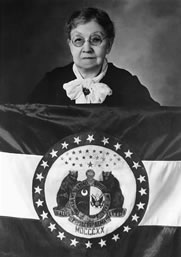The Missouri State Flag
Our flag's story

Missouri State Archives
For nearly a century after achieving statehood, Missouri did not have an official flag. The idea for a flag originated in 1908, when the Daughters of the American Revolution formed a committee to look into designing a state flag. The head of the committee was Mrs. Marie Elizabeth Oliver, wife of Senator Robert Burett Oliver, and a resident of Cape Girardeau. Mrs. Oliver eventually designed the flag herself, and on March 17, 1909, a bill supporting the design was introduced to the Missouri Senate.
It turned out that Mrs. Oliver's design was not the only one being considered by the General Assembly—a second design had been introduced by Dr. N.R. Holcomb. The "Holcomb flag" was opposed by many who felt it resembled too closely the United States flag, and did not symbolize much of Missouri itself. His design did not contain the coat-of-arms, and included nothing that indicated state sovereignty.
Mrs. Oliver's design showed originality, and though simply designed, contained many messages. It took three years and several attempts before the bill for the "Oliver flag" was finally passed. On March 22, 1913, Governor Elliot Major signed the bill into law, and made the Oliver flag the official state flag of Missouri.
Our flag's meaning
The Oliver flag embraced national pride, and at the same time expressed characteristics of Missouri and Missourians. The three large stripes were symbolic of the people of the state—the blue stripe represented vigilance, permanency, and justice, the red represented valor, and the white stripe symbolized purity. The Missouri coat-of-arms appeared in the center of the flag, signifying both Missouri's independence as a state, and its place as a part of the whole United States. Having the coat-of-arms in the center of the national colors represents Missouri, as she is—the geographical center of the nation. By mingling the state coat-of-arms with the national colors of red, white, and blue, the flag signified the harmony existing between the two. Twenty-four stars surrounded the coat-of-arms, representative of Missouri's position as the 24th state admitted to the Union.
The Great Seal of the State of Missouri, the basis of the coat-of-arms, has many special meanings of its own. Robert Wells, who was a lawyer, state legislator and a judge, designed it. The seal shows, by its helmet and buckled belt, that although Missouri is a strong state, it wants to be free to handle its own problems. The grizzly bears signify the size and strength of the state and the courage of her people. The new crescent moon was included to remind us that we can make our future better; it was also a special heraldic symbol pointing out that Missouri was the second state formed out of the Louisiana Purchase. The larger star, rising into a group of 23 stars, was to remind people that Missouri became the 24th state only after solving many difficult problems. The helmet was designed to show the power of the people of the state. Finally, there are two mottoes. "United We Stand, Divided We Fall" tells us how important it is to support the whole United States. "Salus populi suprema lex esto" is Latin which means, "Let the welfare of the people be the supreme law." That reminds us our state government functions to help better our lives.
Our flag is restored
In 1961, Allen Oliver gave the State of Missouri his mother's original flag. It was on public display until the flag began to split and tear due to age, at which point it was put into a storage vault. In 1988, on the flag's 75th birthday, Secretary of State Roy Blunt challenged Missouri elementary students to help raise funds to restore the flag. Thanks to these students, the flag has been restored and is on display at the James C. Kirkpatrick State Information Center in Jefferson City.
Missouri State Archives